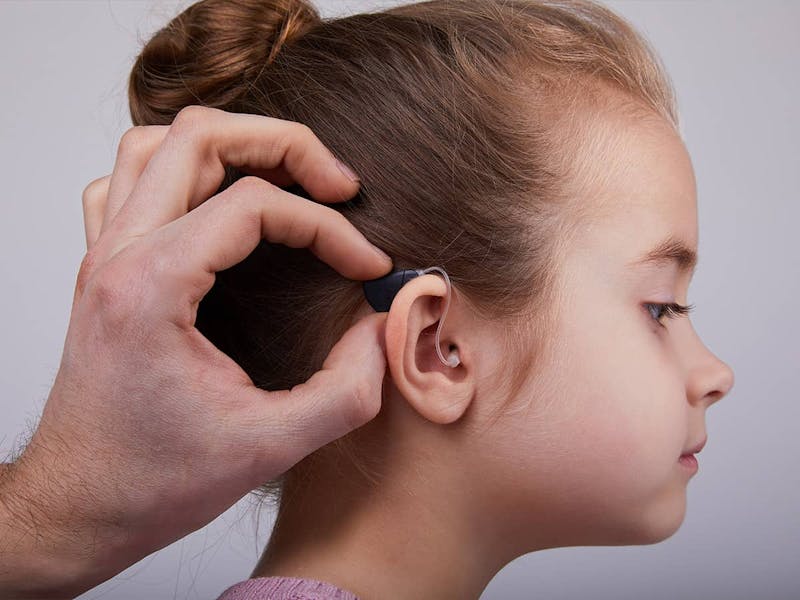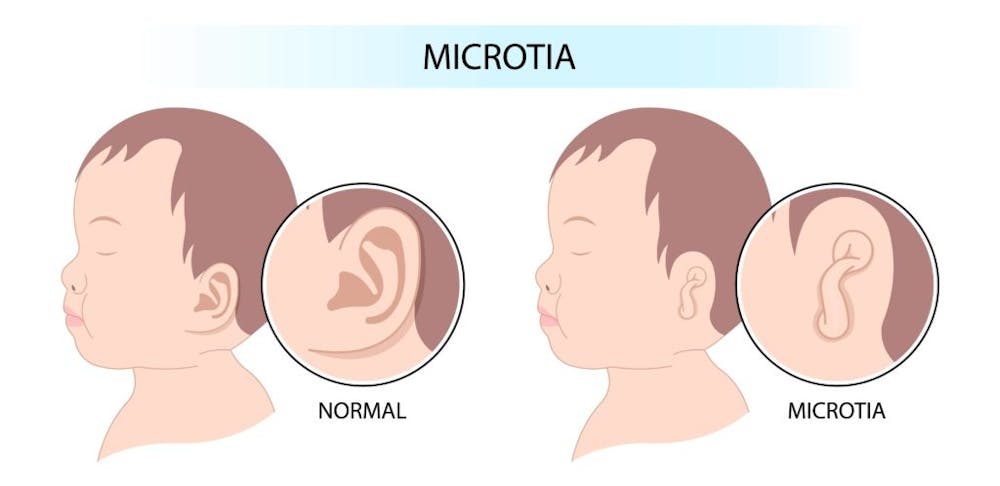
Microtia atresia is a congenital birth defect that affects the development of the outer ear, resulting in hearing and speech impairments. A child with microtia may have aural atresia when the external ear canal is absent or closed. Depending on the type of microtia, hearing loss can range from mild to severe. This condition can also affect speech due to difficulty understanding sound waves and correctly producing sounds.
Microtia atresia affects the eardrum and it can be difficult to treat. Treatment options for microtia may include ear reconstruction surgery, hearing aids, cochlear implants, or a combination of these.
It is important to involve the entire family in the atresia treatment process as they can provide support and understanding during this difficult time. In cases of complete absence of hearing, alternative communication methods such as sign language may be necessary.
Microtia and Atresia Overview
Microtia often co-exists with atresia, wherein the outer ear, as well as the ear canal, form conjointly in the child during pregnancy. In some cases, the ear canal appears normal externally but is blocked internally.
Boys are more likely to have microtia than girls, and the right ear is more likely to be affected than the left. This is called unilateral microtia.
Around 10% of children with microtia have it on both sides, known as bilateral microtia. Approximately, Microtia impacts one out of every 8,000-10,000 births.
The Impact of Microtia Atresia on Speech
1. Expressive language
A child with microtia atresia may have difficulty using and understanding expressive language, including problems with identifying nouns and verbs and expressing their thoughts. They may find it hard to understand directions and find it difficult to initiate conversations or participate in group activities.
2. Receptive Language:
Patients with microtia atresia will likely experience difficulty comprehending what others are saying, along with challenges in taking part in the conversation. This can be down to a lack of opportunity to exercise the ear muscles associated with hearing and listening for language development.
3. Speech Sound Production
As a result of their difficulties hearing, children with microtia atresia may experience difficulty speaking correctly due to not being able to hear the correct sounds correctly or imitate them correctly when producing speech sounds of their own. This could include mispronounced words, distorted vowel sounds, incorrect timing while speaking, or stuttering habits due to an inability to keep up with their own processing speed.
4. Fluency
Even if they can produce speech sounds accurately, individuals suffering from microtia atresia are prone to having difficulty fluently organizing these sounds into meaningful words and phrases due to poor associative linguistic skills. Due to their difficulties comprehending expressions or understanding abstract concepts without visual support, this could mean disorganized and halting speech patterns as well as general problems attaining proper fluency when conversing with other people.
5. Non-Verbal Communication
Patients suffering from microtia atresia might find non-verbal communication such as body language and gestures more difficult than normal because of back experiences around auditory input during childhood that can ultimately leave them unable to fill in the missing pieces for complete comprehension without help from visual cues. They can also encounter issues understanding the intent behind someone’s facial expression or how it positions someone’s mood.
6. Stuttering
Children with Microtia Atresia tend towards higher levels of stuttering than those who do not possess this hearing disability. They struggle to build a framework of patterns expressed through spoken language due to limited development opportunities within early life acquired through monitored hearing inputs, resulting in instances where verbal output doesn’t flow quite right but is interrupted by pauses instead followed by frequent repetition or prolongation of individual syllables.
7. Articulation Issues
Many patients diagnosed with Microtia Atresia display some form of articulation issues, such as those caused by the incorrect placement of teeth upon formation of pronouncing words which leads to further problems. Language assessments can help to identify the areas of difficulty and create a treatment plan that is tailored to the individual’s needs. Treatment plans may include speech therapy, hearing aids, and other assistive devices.

The Impact of Microtia Atresia on Hearing
1. Hearing Loss
The most significant and obvious impact of microtia atresia is hearing loss. Patients with microtia atresia have reduced access to sounds due to the absent or narrow ear canal, which means that the sound waves cannot reach the inner ear and cause normal hearing. As a result, patients with this genetic condition may not be able to hear certain frequencies or volumes of sound unlike people with normal hearing.
Additionally, those with atresia conditions may experience difficulties in understanding speech and other sounds in their environment due to their impaired hearing.
2. Ear Malformation
Ear malformation is a birth deformity that affects the structure of the ear and can cause alterations in its shape. A lack of rib cartilage during a certain period of time during fetal development can cause this condition, which results in an underdeveloped or absent external ear.
Surgical options are available for those with microtia atresia to reconstruct their ears using rib cartilage from other parts of the body. During the reconstructive surgery, the cartilage is then shaped and sculpted into an ear-like structure and placed on the side of the head where it will remain permanently. This type of procedure can help restore some hearing capabilities, as well as improve facial symmetry and appearance. However, you should consider that this corrective surgery does not guarantee normal hearing capabilities and may require additional treatments such as hearing aids or cochlear implants to achieve optimal results.
3. Learning Delay
Children with Microtia Atresia are at risk of learning delays due to the conductive hearing loss caused by the congenital deformity. During the first trimester of pregnancy, a unilateral microtia can occur which results in an auditory ear canal that is either absent or narrow. This can lead to a reduced ability to hear and process sound, resulting in difficulty understanding speech and other sounds in their environment. As a result, children with this genetic condition may experience delays in language development, communication skills, and academic performance.
To help reduce the impact of these learning delays, it is important for parents to seek early intervention services such as hearing aids, that can help amplify sound so that it is easier for children with microtia atresia to understand other people.
Additionally, parents should also consider alternative communication methods such as sign language if necessary. With early intervention and support from family members, children with microtia atresia can still reach their full potential despite their hearing disability.
4. Need For Amplification Devices
Children with hearing loss due to microtia atresia may require the use of amplification devices in order to hear properly. Bone-conduction hearing devices, implantable devices, and conductive hearing devices are all options that improve a person’s ability to hear.
Bone conduction hearing aids are worn behind the ear and work by transmitting sound waves through the bones of the skull directly to the inner ear. This type of device is often recommended for children with microtia atresia as it does not require corrective surgery or any other invasive procedure. Additionally, these devices come with a sound processor with adjustments options according to individual needs and preferences.
Implantable devices such as cochlear implants are also available for those who need more advanced hearing solutions. These implants involve surgically placing an electronic device inside the ear which helps amplify sound signals directly into the inner ear.
Lastly, conductive hearing devices such as bone-anchored hearing aids (BAHA) are also available for those who need additional assistance in amplifying sound. BAHA works by attaching a small titanium implant onto the bone behind the ear which then transmits sound vibrations directly into the inner ear.
5. Inability To Produce Sounds
Children with microtia atresia may also experience difficulty in producing sounds due to the lack of an auditory ear canal. Without a functioning ear canal, sound waves are unable to travel through the outer and middle ear and reach the inner ear, resulting in a reduced ability to produce sound. This can lead to difficulties in speech production, as well as an inability to produce certain sounds or tones.
To help address this issue, your doctor may recommend hearing tests and speech therapy for children with microtia atresia. Speech therapists can help children learn how to use their vocal cords properly and teach them techniques on how to produce clearer sounds. As part of a care plan for permanent hearing loss, hearing aids or cochlear implants are essential to amplify sound signals so that they can be heard more clearly by the inner ear.
6. Affects Social Interaction
Children with microtia atresia may experience difficulty in social interaction due to their facial differences and hearing loss. It is important for healthcare providers to provide individualized care and comprehensive treatment options that address both the physical and emotional needs of these children. Facial differences can lead to feelings of insecurity, which can affect a child’s ability to interact with others.
Additionally, hearing loss can make it difficult for children to understand conversations or follow instructions, leading to further social isolation. To help address these issues, healthcare providers should focus on providing quality care that includes appearance treatment options as well as differences in shape and size of the ear. With proper support from family members and health care professionals, children with microtia atresia can still have meaningful relationships despite their disabilities.
The Emotional Impact on Families Living with Microtia Atresia
The emotional impact of living with microtia atresia can be significant for families. Genetic factors often cause the condition, but environmental factors can also play a role. This means that parents may feel overwhelmed and helpless when their child is diagnosed with the condition. Language specialists and other professionals can help to provide support and guidance to families as they navigate the challenges of living with microtia atresia.
Families affected by microtia atresia may benefit from attending conferences specifically designed for them. These conferences provide an opportunity for families to connect with others who are going through similar experiences, as well as learn more about the condition and available treatments. Atresia surgery is one option available to children with microtia atresia, but it is important for families to understand all of their options before making a decision.
Microtia surgery Pasadena patients may also need additional support in managing their condition. Innovative care plans should be tailored to meet the individual needs of each patient, including comprehensive treatment plans that address both physical and emotional needs. Healthcare quality is essential in providing effective care for children and adults living with microtia atresia, so consultations with professionals are indispensable.
Schedule a consultation
If your child has microtia or another ear deformity, then board-certified facial plastic surgeon Dr. Panossian may be able to help. Schedule an ear reconstruction consultation at our Pasadena office to learn more about the current treatment options and your child’s candidacy. Call 626-765-6885 today to make an appointment with our welcoming staff.


